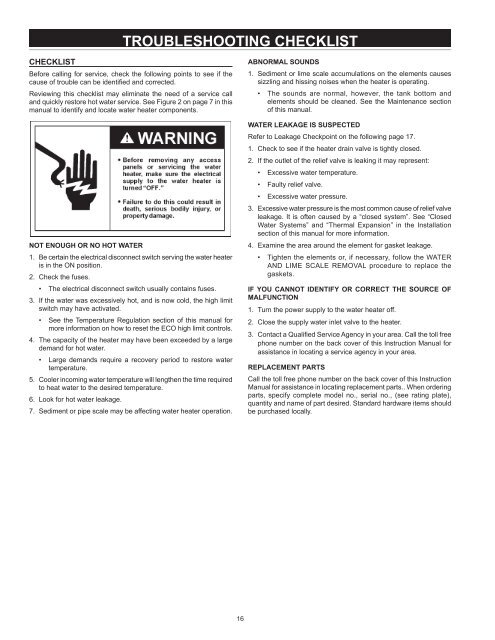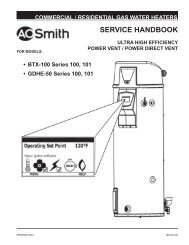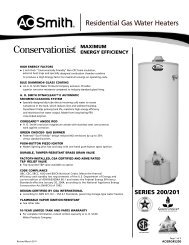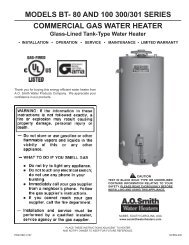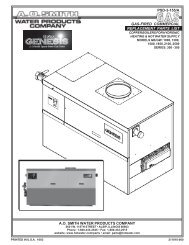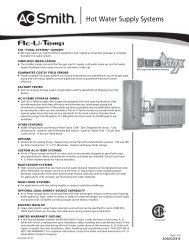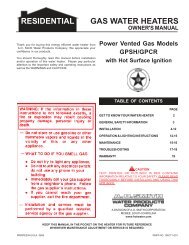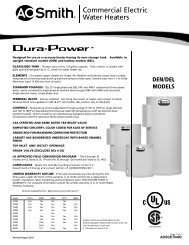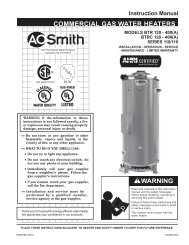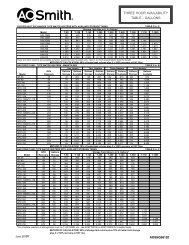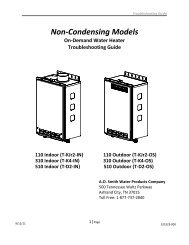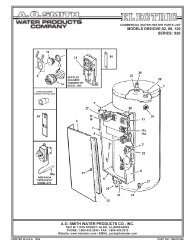322055-000 - AO Smith Water Heaters
322055-000 - AO Smith Water Heaters
322055-000 - AO Smith Water Heaters
Create successful ePaper yourself
Turn your PDF publications into a flip-book with our unique Google optimized e-Paper software.
TROUBLESHOOTING CHECKLIST<br />
Checklist<br />
Before calling for service, check the following points to see if the<br />
cause of trouble can be identified and corrected.<br />
Reviewing this checklist may eliminate the need of a service call<br />
and quickly restore hot water service. See Figure 2 on page 7 in this<br />
manual to identify and locate water heater components.<br />
Not enough or no hot water<br />
1. Be certain the electrical disconnect switch serving the water heater<br />
is in the ON position.<br />
2. Check the fuses.<br />
• The electrical disconnect switch usually contains fuses.<br />
3. If the water was excessively hot, and is now cold, the high limit<br />
switch may have activated.<br />
• See the Temperature Regulation section of this manual for<br />
more information on how to reset the ECO high limit controls.<br />
4. The capacity of the heater may have been exceeded by a large<br />
demand for hot water.<br />
• Large demands require a recovery period to restore water<br />
temperature.<br />
5. Cooler incoming water temperature will lengthen the time required<br />
to heat water to the desired temperature.<br />
6. Look for hot water leakage.<br />
7. Sediment or pipe scale may be affecting water heater operation.<br />
ABNORMAL SOUNDS<br />
1. Sediment or lime scale accumulations on the elements causes<br />
sizzling and hissing noises when the heater is operating.<br />
• The sounds are normal, however, the tank bottom and<br />
elements should be cleaned. See the Maintenance section<br />
of this manual.<br />
<strong>Water</strong> leakage is suspected<br />
Refer to Leakage Checkpoint on the following page 17.<br />
1. Check to see if the heater drain valve is tightly closed.<br />
2. If the outlet of the relief valve is leaking it may represent:<br />
• Excessive water temperature.<br />
• Faulty relief valve.<br />
• Excessive water pressure.<br />
3. Excessive water pressure is the most common cause of relief valve<br />
leakage. It is often caused by a “closed system”. See “Closed<br />
<strong>Water</strong> Systems” and “Thermal Expansion” in the Installation<br />
section of this manual for more information.<br />
4. Examine the area around the element for gasket leakage.<br />
• Tighten the elements or, if necessary, follow the WATER<br />
AND LIME SCALE REMOVAL procedure to replace the<br />
gaskets.<br />
IF YOU CANNOT IDENTIFY OR CORRECT THE SOURCE OF<br />
MALFUNCTION<br />
1. Turn the power supply to the water heater off.<br />
2. Close the supply water inlet valve to the heater.<br />
3. Contact a Qualified Service Agency in your area. Call the toll free<br />
phone number on the back cover of this Instruction Manual for<br />
assistance in locating a service agency in your area.<br />
REPLACEMENT PARTS<br />
Call the toll free phone number on the back cover of this Instruction<br />
Manual for assistance in locating replacement parts.. When ordering<br />
parts, specify complete model no., serial no., (see rating plate),<br />
quantity and name of part desired. Standard hardware items should<br />
be purchased locally.<br />
16


